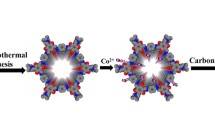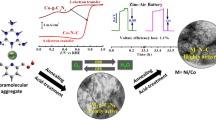Abstract
Efficient and cost-effective non-precious metal catalysts play a crucial role in the evolution of energy storage and conversion technologies. This work introduces a novel cobalt–nickel bimetallic catalyst (Cox/Niy–N–C), synthesized via SiO2 spheres as templates and ZIF-8 as precursors, aiming to address this critical need. The Co1Ni1–N–C catalyst, synthesized with a 1:1 Co to Ni doping ratio, displayed exceptional electrocatalytic activity for oxygen reduction. Its impressive half-wave potential of 0.81 V and limiting current density of 4.89 mA cm−2 nearly approached those of Pt/C catalysts (0.82 V and 5.09 mA cm−2), showcasing its competitive edge. Integration of the Co1Ni1–N–C catalyst into a zinc-air battery demonstrated substantial promise, yielding a commendable power density of 185.17 mW cm−2, marginally trailing behind the commercial Pt/C catalyst (198.33 mW cm−2). By offering a cost-effective alternative without compromising efficiency, this research significantly contributes to the wider adoption of sustainable energy technologies.






Similar content being viewed by others
Data availability
All data generated or analyzed during this study are included in this published article (and its supplementary information files).
References
M.M. Bu, Y. Liu, S.X. Liao et al., In-site grown carbon nanotubes connecting Fe/Cu-N-C polyhedrons as robust electrocatalysts for Zn-air batteries. Carbon 214, 118365 (2023)
N.F.H.N. Zaiman, N. Shaari et al., Review on flower-like structure nickel based catalyst in fuel cell application. J. Ind. Eng. Chem. 119, 1–76 (2023)
M. Sridharan, T. Maiyalagan, Synergistically enhanced electrocatalytic activity of cerium oxide/manganese tungstate composite for oxygen reduction reaction. J. Mater. Sci. Mater. Electron. 33, 9538–9548 (2022)
X.L. Tian, X.F. Lu, B.Y. Xia et al., Advanced electrocatalysts for the oxygen reduction reaction in energy conversion technologies. Joule. 4, 45–68 (2020)
H.C. Huang, C.Y. Su, K.C. Wang et al., Nanostructured cementite/ferrous sulfide encapsulated carbon with heteroatoms for oxygen reduction in alkaline environment. ACS Sustain. Chem. Eng. 7, 3185–3194 (2019)
S.Y. Yu, Z. Guo, Y. Zhou et al., Research progress of MOFs/carbon nanocomposites on promoting ORR in microbial fuel cell cathodes. Environ. Sci. Pollut. Res. 30, 93422–93434 (2023)
H.W. Gao, Y.H. Wang, W. Li et al., One-step carbonization of ZIF-8 in Mn-containing ambience to prepare Mn, N co-doped porous carbon as efficient oxygen reduction reaction electrocatalyst. Int. J. Hydrogen Energy 46, 36742–36752 (2021)
W.M. Yang, X.Y. Wang, Y.F. Yan et al., Co3O4 nanofibers compounded with Pt/C as efficient bifunctional electrocatalysts for rechargeable Zn-air battery. J. Mater. Sci. Mater. Electron. 34, 871 (2023)
S.L. Zhao, Z.Z. Ma, Z.H. Wan et al., Noble-Metal-Free FeMn-N-C catalyst for efficient oxygen reduction reaction in both alkaline and acidic media. J. Colloid Interface Sci. 642, 800–809 (2023)
Q. Chen, Z. Zhang, R.Q. Zhang et al., Recent progress of non-Pt catalysts for oxygen reduction reaction in fuel cells. Processes. 11, 361 (2023)
H.M. Xu, S.Q. Ci, Y.C. Ding et al., Recent advances in precious metal-free bifunctional catalysts for electrochemical conversion systems. J. Mater. Chem. A 7, 8006–8029 (2019)
H. Zhang, Q.D. Sun, Q. He et al., Single Cu atom dispersed on S, N-codoped nanocarbon derived from shrimp shells for highly-efficient oxygen reduction reaction. Nano Res. 15, 5995–6000 (2022)
Q.H. Wu, M.L. Liu, N.Z. Shang et al., Preparation of N, S co-decorated carbon supported iron species for oxygen reduction and zinc air batteries. J. Alloys Compd. 848, 156367 (2020)
C. Zhang, J. Liu, Y.X. Ye et al., Encapsulation of Co-based nanoparticle in N-doped graphitic carbon for efficient oxygen reduction reaction. Carbon 156, 31–37 (2020)
S.B. Zou, J.J. Li, X.Q. Wu et al., Electrospun N-doped carbon nanofibers decorated with Fe3C nanoparticles as highly active oxygen reduction electrocatalysts for rechargeable Zn-air batteries. Chem. Phys. Lett. 778, 138769 (2021)
W. Pei, S. Zhou, Y. Bai et al., N-doped graphitic carbon materials hybridized with transition metals (compounds) for hydrogen evolution reaction: understanding the synergistic effect from atomistic level. Carbon 133, 260–266 (2018)
F.H. Lu, K.C. Fan, L.X. Cui et al., Engineering FeN4 active sites onto nitrogen-rich carbon with tubular channels for enhanced oxygen reduction reaction performance. Appl. Catal. B 313, 121464 (2022)
L.J. Yang, J.L. Shui, L. Du et al., Carbon-based metal-free ORR electrocatalysts for fuel cells: past, present, and future. Adv. Mater. 31, 1804799 (2019)
Y. Zhang, W. Xiao, T. Hu et al., Metal-organic frameworks-inspired design of highly efficient nitrogen-doped carbon nanoflower electrocatalysts for Zn-air batteries. J. Mater. Sci. 58, 8157–8168 (2023)
Z.M. Che, Y.A. Yuan, J.X. Qin et al., Progress of nonmetallic electrocatalysts for oxygen reduction reactions. Nanomaterials 13, 1945 (2023)
D.H. Wang, C.C. Ao, X.K. Liu et al., Coordination-engineered Cu−Nx single-site catalyst for enhancing oxygen reduction reaction. ACS Appl. Energy Mater. 2, 6497–6504 (2019)
Y.L. Wu, J.L. Huang, Z.P. Lin et al., Fe-Nx doped carbon nanotube as a high efficient cathode catalyst for proton exchange membrane fuel cell. Chem. Eng. J. 423, 130241 (2021)
T. Asset, P. Atanassov, Iron-nitrogen-carbon catalysts for proton exchange membrane fuel cells. Joule 4, 33–44 (2020)
Z. Guan, X.J. Zhang, J.J. Fang et al., Fe, Ni, S, N-doped carbon materials as highly active Bi-functional catalysts for rechargeable Zinc-Air battery. Mater. Lett. 258, 126826 (2020)
X.F. Li, Y.J. Liu, H.B. Chen et al., Rechargeable Zn-Air batteries with outstanding cycling stability enabled by ultrafine FeNi nanoparticles-encapsulated N-doped carbon nanosheets as a bifunctional electrocatalyst. Nano Lett. 21, 3098–3105 (2021)
W.J. Fan, Z.L. Li, C.H. You et al., Binary Fe, Cu-doped bamboo-like carbon nanotubes as efficient catalyst for the oxygen reduction reaction. Nano Energy 37, 187–194 (2017)
L. Yang, D. Wang, Y. Lv et al., Nitrogen-doped graphitic carbons with encapsulated CoNi bimetallic nanoparticles as bifunctional electrocatalysts for rechargeable Zn-Air batteries. Carbon 144, 8–14 (2019)
T.T. Gao, Z.Y. Jin, Y.J. Zhang et al., Coupling cobalt-iron bimetallic nitrides and N-doped multi-walled carbon nanotubes as high-performance bifunctional catalysts for oxygen evolution and reduction reaction. Electrochim. Acta 258, 51–60 (2017)
S. Zhao, Z. Ma, Z. Wan et al., Noble-Metal-Free FeMn-N-C catalyst for efficient oxygen reduction reaction in both alkaline and acidic media. J. Colloid Interf. Sci. 642, 800–809 (2023)
Q.R. Pan, P.Y. Jiang, B.L. Lai et al., Co, N co-doped hierarchical porous carbon as efficient cathode electrocatalyst and its impact on microbial community of anode biofilm in microbial fuel cell. Chemosphere 291, 132701 (2022)
L.J. Peng, J.P. Huang, Q.R. Pan et al., A simple method for the preparation of a nickel selenide and cobalt selenide mixed catalyst to enhance bifunctional oxygen activity for Zn-air batteries. RSC Adv. 11, 19406–19416 (2021)
X.W. Peng, L. Zhang, Z.X. Chen et al., Hierarchically porous carbon plates derived from wood as bifunctional ORR/OER electrodes. Adv. Mater. 31, 1900341 (2019)
Q.J. Niu, J.X. Guo, B.L. Chen et al., Bimetal-organic frameworks/polymer core-shell nanofibers derived heteroatom-doped carbon materials as electrocatalysts for oxygen reduction reaction. Carbon 114, 250–260 (2017)
D.D. Lyu, Y.H. Du, S.L. Huang et al., Highly efficient multifunctional Co–N–C electrocatalysts with synergistic effects of Co–N moieties and Co metallic nanoparticles encapsulated in a N-doped carbon matrix for water-splitting and oxygen redox reactions. ACS Appl. Mater. Interfaces 11, 39809–39819 (2019)
D.H. Guo, R. Shibuya, C. Akiba et al., Active sites of nitrogen-doped carbon materials for oxygen reduction reaction clarified using model catalysts. Science 351, 361–365 (2016)
Funding
This work was supported by National Natural Science Foundation of China (No.52370096), Basic and Applied Basic Research Foundation of Guangdong Province (No. 2023A1515012759), and Innovative Training Program for University Students (No. S202311078049).
Author information
Authors and Affiliations
Contributions
Jie-Ping Huang: investigation, writing—original draft. Qiu-Ren Pan: conceptualization and validation. Hui-Huan Jiang: investigation. Xiao-Feng Zhou: investigation. Nan Li: conceptualization, supervision, and writing—original draft.
Corresponding author
Ethics declarations
Conflict of interest
The authors declare no conflict of interest.
Additional information
Publisher's Note
Springer Nature remains neutral with regard to jurisdictional claims in published maps and institutional affiliations.
Supplementary Information
Below is the link to the electronic supplementary material.
Rights and permissions
Springer Nature or its licensor (e.g. a society or other partner) holds exclusive rights to this article under a publishing agreement with the author(s) or other rightsholder(s); author self-archiving of the accepted manuscript version of this article is solely governed by the terms of such publishing agreement and applicable law.
About this article
Cite this article
Huang, JP., Pan, QR., Jiang, HH. et al. Cobalt–nickel bimetallic hybridized nitrogen-doped hierarchical porous carbon as efficient oxygen reduction electrocatalyst. J Mater Sci: Mater Electron 35, 1165 (2024). https://doi.org/10.1007/s10854-024-12948-z
Received:
Accepted:
Published:
DOI: https://doi.org/10.1007/s10854-024-12948-z




